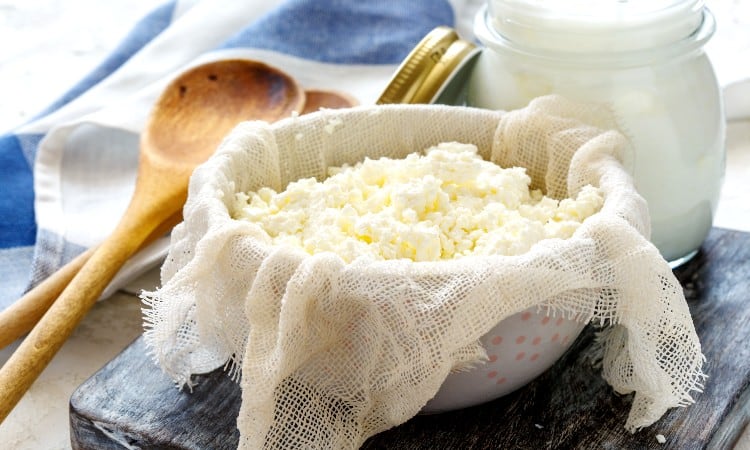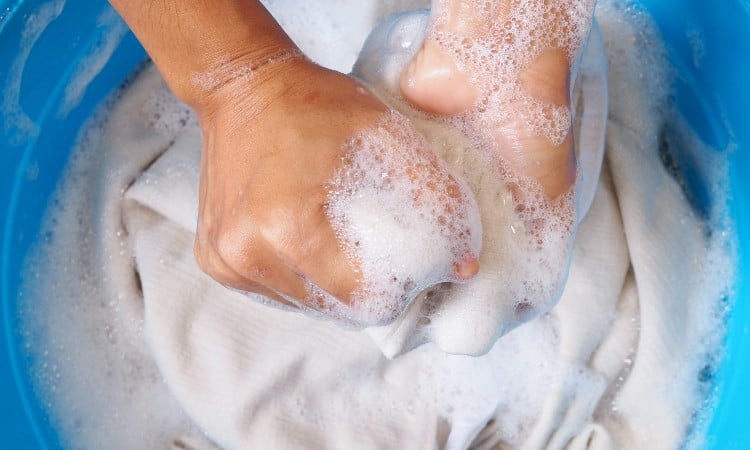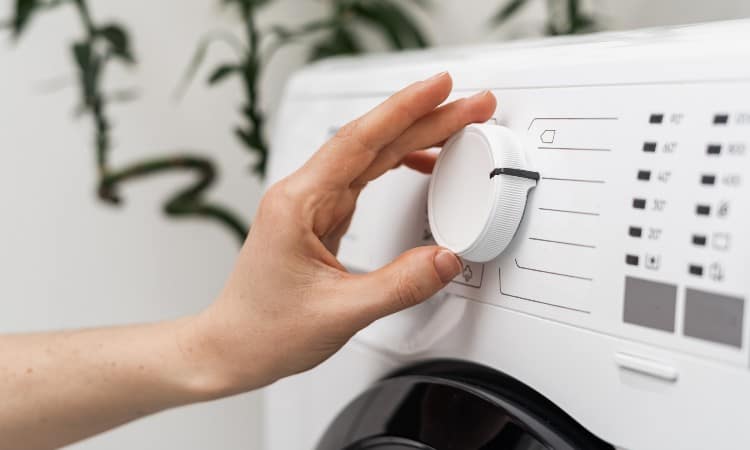Whether you use the traditional cheesecloth made of gauzy cotton fabric or you use muslin, buying new cheesecloth every time you need it can seem wasteful. Can you clean cheesecloth and reuse it? After all, it is just a specific type of fabric.
Although some cheesecloth is not designed to be reused, a lot of it can be. You can clean cheesecloth by hand-washing or machine washing it, but you want to do so in a way that all traces of food and bacteria are removed so that it doesn’t contaminate any future cheese, milk, etc., that you’re making.
In this article, you will learn how to clean cheesecloth so that you can use it again. I’ll explain how to best remove any traces of food from the cheesecloth and how to sanitize it so that bacteria are killed. Finally, I’ll explain how to store cheesecloth when it is not being used.

Quick Navigation
Can You Reuse Cheesecloth?
Yes, you absolutely can. Many people want to reuse cheesecloth, so they don’t have to buy more of it. Some types of cheesecloth are for one-time use, but as long as the cheesecloth is high-quality and still in good shape, you can reuse it.
With that being said, you may not be able to use a single piece of cheesecloth forever. Since it is a gauzy type of fabric, it may fray or break down over time. But, reusing cheesecloth as much as possible can help cut down on how much money you spend replacing it and cut down on waste as well.
Can You Clean Cheesecloth?
If you’re going to reuse cheesecloth, it’s important that you clean it well between uses. Not only can you clean cheesecloth, but because it is usually used to make certain types of food at home, you want to make sure that you clean it thoroughly to remove stains and prevent bacteria growth.
You’ll also need to remove all traces of food if you want to reuse it. This is because food remnants can be a breeding ground for bacteria, and if you don’t clean it thoroughly to remove the food and bacteria, it can transfer to whatever cheese (for example) you’re making. Depending on the type of bacteria, this can make you sick or make the food spoil faster than you want it to.
Are You Supposed To Wash Cheesecloth?
Cheesecloth usually says it is designed for one-time use, but that doesn’t mean that you can’t wash it and reuse it. However, depending on the type and quality of the cheesecloth, some of it can only be washed a certain number of times before it starts to break down.
If you’re using high-quality cheesecloth or cheesecloth that is just stronger in general, you may be able to wash and reuse them over and over again for as long as you can until the cloth starts to break down.
You don’t want cheesecloth to break down because it can affect how well it functions. Since cheesecloth is essentially used for straining, breaking down can affect how well the cheesecloth strains. Depending on the overall durability of the cheesecloth, it can affect how you wash it to keep it from breaking down.
How to Clean Cheesecloth
If you are going to clean and reuse cheesecloth, it’s important that you do so properly. Remember that you want to remove all traces of food from the cloth and sanitize it afterward. You likely won’t be able to remove all of the stains from the cloth, which is why removing the food and sanitizing it is so important.
You don’t want to use any chemical stain removers to try to remove the stains, as they can leave behind residue that could transfer to food. You may be able to lessen the stains with natural products, but depending on the source of the stain, you may not be able to remove it completely.
Even if the cheesecloth is stained, that doesn’t mean that it isn’t clean. Following the steps below is essential for getting the cheesecloth as clean as possible to reuse it without worrying about bacteria or getting sick.
Hand-Wash

One way to clean cheesecloth is to hand-wash it. If the cheesecloth isn’t high-quality or isn’t designed to be reused, then you’ll want to hand-wash it because hand-washing fabrics is a more delicate process that can help prevent the fabric from breaking down.
You also don’t want to use any harsh chemicals on the cheesecloth that could lead to the fibers breaking down or leave behind residue, especially during hand-washing since the fabric doesn’t get as thorough of a rinse as it would in the washing machine. That’s why it’s important to follow these steps carefully to ensure that the cheesecloth gets cleaned thoroughly.
Rinse
If you’re planning on reusing cheesecloth, you’ll want to immediately rinse it after use to remove all traces of food. If you don’t rinse it immediately, any food residue or stains will be harder to remove completely. Make sure to rinse it under hot water as hot water will rinse the food better than cold water. If you can’t rinse it immediately, at least soak it in hot water and then rinse it as soon as you can.
Soak in Baking Soda
After rinsing off the cheesecloth, you’ll want to fill a sink or tub with more hot water. Add ½ cup of baking soda for every gallon of water and let the cheesecloth soak in the baking soda and water solution. The baking soda helps break down stains, so you’ll want to leave the cheesecloth in the water for up to 30 minutes, depending on how stained it is.
Soak in Vinegar/Lemon Juice
If the water in the sink or tub has cooled, replace it with more hot water, then add ¼ up of white vinegar lemon juice to the water for each gallon. If the water is still hot, add the vinegar or lemon juice directly into the water with the baking soda. Let it soak for another 10-15 minutes, then remove it from the water and rinse it thoroughly to remove the lemon juice or vinegar.
Another option you have if you’re in a hurry is to soak the cheesecloth in baking soda and vinegar or baking soda and lemon juice at the same time. For extra stubborn stains, you can dip a toothbrush in vinegar or lemon juice and gently scrub the stain. Just remember to thoroughly rinse it afterward.
Boil It
After removing as many stains as possible, you’ll want to boil the cheesecloth to remove the bacteria. Fill a pot with water and turn the stove on. Once the water starts boiling, add the cheesecloth and let it soak for around 5 minutes to kill bacteria.
After boiling it, some of the stains may still be there. But boiling sterilizes the cheesecloth, so as long as it has been sterilized, it is still safe to use. Finally, place the cheesecloth in the dryer or hang it outside in the sun to dry.
Machine Wash

Cheesecloth designed to be reused is often more durable, so it can be put into the washing machine. If you use muslin fabric as cheesecloth, it can go into the washing machine. However, you still want to make sure that you wash it as soon as possible. Rinse it or soak it in hot water immediately after use to remove food residue.
After rinsing it:
- Plan to wash it as soon as possible.
- Don’t leave it in a laundry basket because it can still grow bacteria or mildew or if it is stained, it can stain other fabrics in the basket as well plus, it will be harder to get completely clean if you wait.
- When putting it in the washing machine, use a delicate or free and clear detergent that doesn’t contain any harsh chemicals.
These chemicals can also leave behind residue or break down the fibers.
When washing cheesecloth, use warm or hot water to get it as clean as possible. Wash it on the gentle cycle as well. After washing, do a cold water rinse with oxygen bleach, not chlorine bleach. Oxygen bleach is safer and can remove stains and sterilize it by killing bacteria, mildew, mold, etc. If you don’t feel safe using any type of bleach on cheesecloth, you can boil it for 5 minutes instead of sterilizing it. Then, place it in the dryer or hang it outside in the sun to dry.
Can You Put Cheesecloth in the Dishwasher?
Since cheesecloth is designed to be used in the kitchen, you may be wondering if you can just put cheesecloth in the dishwasher to wash it. You can put cheesecloth in the dishwasher, but you still need to rinse it off using hot water first. You don’t want to put it in the dishwasher with food still on it because the dishwasher may not get all of the food residues off.
If you’re putting it in the dishwasher, you’ll also want to place it on the top shelf of the dishwasher, not the bottom. The bottom shelf can be too aggressive for cheesecloth, especially cheesecloth that isn’t designed to be reused.
You’ll also want to use a gentler dishwasher detergent, whether dishwashing powder, pods, tablets, etc. Run a normal, hot water dishwashing cycle, and if your dishwasher has one, use the sanitizing function. Note that if you use a dryer cycle in the dishwasher, it may not make the cheesecloth completely dry.
If your dishwasher does not have a sanitize function, it’s still a good idea to boil it afterward to make sure that it gets sanitized if the dishwasher didn’t remove all of the bacteria. You’ll still need to boil it for about 5 minutes. Whether or not you used the drying function on the dishwasher, you may still need to put the cheesecloth in the dryer or hang it outside to dry thoroughly.
Can You Boil Cheesecloth?
You can boil cheesecloth, and it’s a good idea to boil new cheesecloth for at least two minutes before using it for the first time to remove any chemicals or residue that may be on it from manufacturing. I also mentioned throughout the article that you’ll want to boil cheesecloth after washing it just to kill any bacteria and sanitize it before using it again.
However, you don’t want to just boil it to clean it. You’ll still want to thoroughly rinse off the food and either hand-wash it or machine-wash it before boiling it to remove as much food residue as possible. If you just throw it into boiling water immediately after using it, it won’t get as clean because the residue will still be in the water.
Boiling it in clean water after washing it is the best way to ensure that it gets sanitized and thoroughly cleaned. Make sure the water is boiling before you put the cheesecloth into it also, and start timing the 5 minutes after you put the cheesecloth into the boiling water.
How to Store Cheesecloth
Once the cheesecloth has been cleaned and is completely dry, you want to make sure that you store it properly to prevent bacteria from getting on it and to keep it from getting wet. If it gets wet or is stored in a damp place, it can cause mold and mildew to grow on it. That’s why you also want to make sure that it is completely dry before you store it in the first place.
The best way to store cheesecloth is to fold it up and store it in a sealable plastic bag. You want the bag to be as airtight as possible. Then, store the bag in a cool, dry place such as a drawer or closet until you’re ready to use it again. As long as the cheesecloth was thoroughly cleaned and sanitized before you stored it and as long as the bag remained sealed, you shouldn’t have to clean or sanitize it again before you use it.
Conclusion
Although some types of cheesecloth specify that they are a single-use product, you can reuse them. There are some types of cheesecloth that are stronger and are designed to be reused. In either case, you want to make sure that you clean the cheesecloth thoroughly before you try to reuse it.
If you don’t clean it thoroughly, you may be left with food residue, bacteria, etc., on the cheesecloth that can contaminate any future food that you make with it. You can clean it by either hand-washing, machine-washing, or putting it in the dishwasher, but you want to make sure you boil it afterward to sanitize it.